Comprehensive Analysis of the Marketing Communication Industry
VerifiedAdded on 2024/05/23
|24
|8620
|487
Homework Assignment
AI Summary
This assignment provides a detailed overview of the marketing communication industry. It begins by describing the communication process, including source, message, and channel factors, and then explores the operation of the marketing communication industry, emphasizing the shift from traditional to online media. The assignment discusses structuring a marketing operations team and identifying the structure of the marketing communications industry, including examples of different organizational structures. It lists prominent marketing industry associations in Australia and various marketing communication industry sectors. Key stakeholders in the industry are identified, along with their roles and responsibilities. The document contrasts old and new marketing rules, highlighting the impact of technology and changing customer focus. The role of the marketing communication industry in society is examined, emphasizing benefits to customers, improved product quality, and enhanced communication. Finally, the benefits of integrated communication marketing are described, and various agency roles within the marketing communication industry are explained.
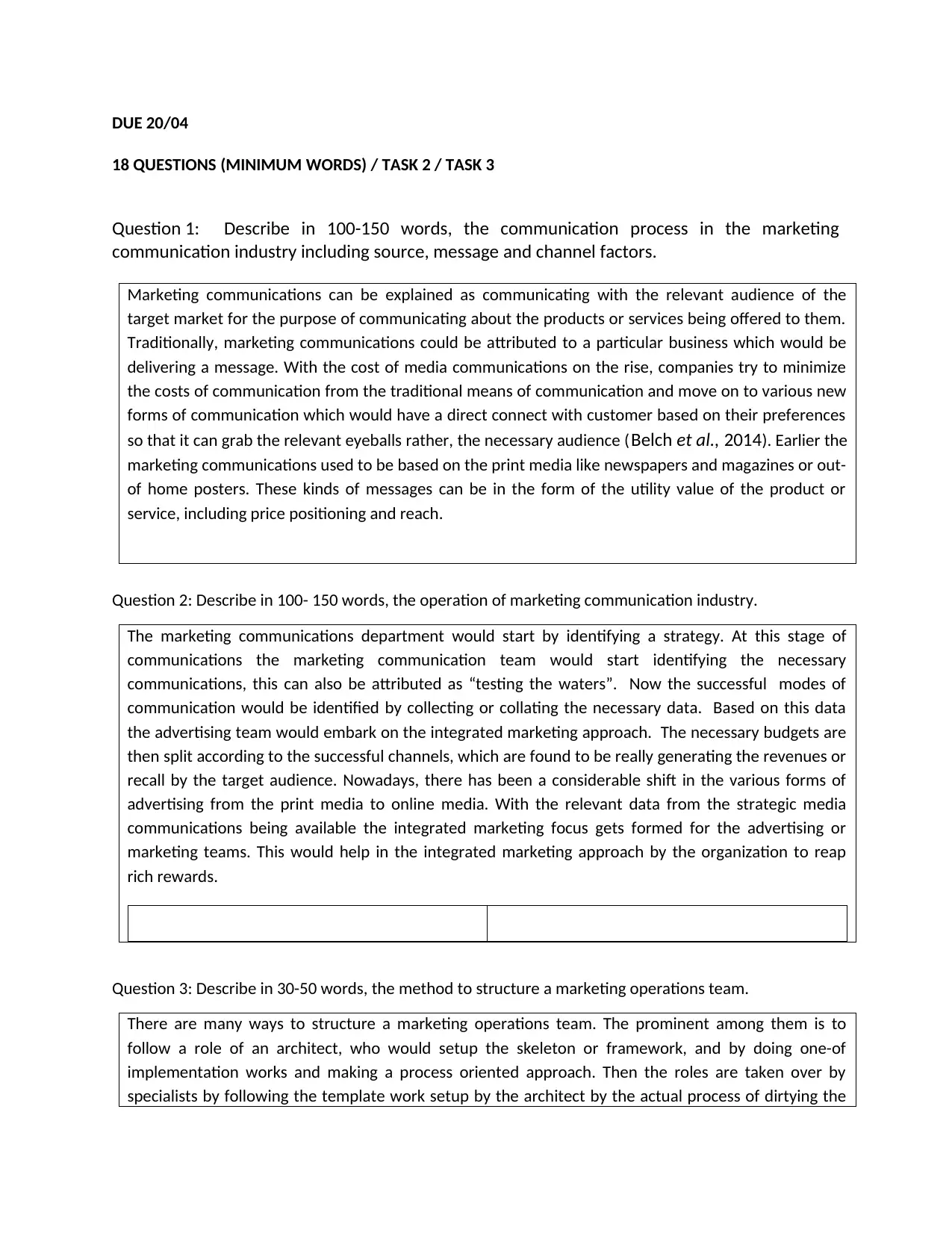
DUE 20/04
18 QUESTIONS (MINIMUM WORDS) / TASK 2 / TASK 3
Question 1: Describe in 100-150 words, the communication process in the marketing
communication industry including source, message and channel factors.
Marketing communications can be explained as communicating with the relevant audience of the
target market for the purpose of communicating about the products or services being offered to them.
Traditionally, marketing communications could be attributed to a particular business which would be
delivering a message. With the cost of media communications on the rise, companies try to minimize
the costs of communication from the traditional means of communication and move on to various new
forms of communication which would have a direct connect with customer based on their preferences
so that it can grab the relevant eyeballs rather, the necessary audience (Belch et al., 2014). Earlier the
marketing communications used to be based on the print media like newspapers and magazines or out-
of home posters. These kinds of messages can be in the form of the utility value of the product or
service, including price positioning and reach.
Question 2: Describe in 100- 150 words, the operation of marketing communication industry.
The marketing communications department would start by identifying a strategy. At this stage of
communications the marketing communication team would start identifying the necessary
communications, this can also be attributed as “testing the waters”. Now the successful modes of
communication would be identified by collecting or collating the necessary data. Based on this data
the advertising team would embark on the integrated marketing approach. The necessary budgets are
then split according to the successful channels, which are found to be really generating the revenues or
recall by the target audience. Nowadays, there has been a considerable shift in the various forms of
advertising from the print media to online media. With the relevant data from the strategic media
communications being available the integrated marketing focus gets formed for the advertising or
marketing teams. This would help in the integrated marketing approach by the organization to reap
rich rewards.
Question 3: Describe in 30-50 words, the method to structure a marketing operations team.
There are many ways to structure a marketing operations team. The prominent among them is to
follow a role of an architect, who would setup the skeleton or framework, and by doing one-of
implementation works and making a process oriented approach. Then the roles are taken over by
specialists by following the template work setup by the architect by the actual process of dirtying the
18 QUESTIONS (MINIMUM WORDS) / TASK 2 / TASK 3
Question 1: Describe in 100-150 words, the communication process in the marketing
communication industry including source, message and channel factors.
Marketing communications can be explained as communicating with the relevant audience of the
target market for the purpose of communicating about the products or services being offered to them.
Traditionally, marketing communications could be attributed to a particular business which would be
delivering a message. With the cost of media communications on the rise, companies try to minimize
the costs of communication from the traditional means of communication and move on to various new
forms of communication which would have a direct connect with customer based on their preferences
so that it can grab the relevant eyeballs rather, the necessary audience (Belch et al., 2014). Earlier the
marketing communications used to be based on the print media like newspapers and magazines or out-
of home posters. These kinds of messages can be in the form of the utility value of the product or
service, including price positioning and reach.
Question 2: Describe in 100- 150 words, the operation of marketing communication industry.
The marketing communications department would start by identifying a strategy. At this stage of
communications the marketing communication team would start identifying the necessary
communications, this can also be attributed as “testing the waters”. Now the successful modes of
communication would be identified by collecting or collating the necessary data. Based on this data
the advertising team would embark on the integrated marketing approach. The necessary budgets are
then split according to the successful channels, which are found to be really generating the revenues or
recall by the target audience. Nowadays, there has been a considerable shift in the various forms of
advertising from the print media to online media. With the relevant data from the strategic media
communications being available the integrated marketing focus gets formed for the advertising or
marketing teams. This would help in the integrated marketing approach by the organization to reap
rich rewards.
Question 3: Describe in 30-50 words, the method to structure a marketing operations team.
There are many ways to structure a marketing operations team. The prominent among them is to
follow a role of an architect, who would setup the skeleton or framework, and by doing one-of
implementation works and making a process oriented approach. Then the roles are taken over by
specialists by following the template work setup by the architect by the actual process of dirtying the
Paraphrase This Document
Need a fresh take? Get an instant paraphrase of this document with our AI Paraphraser
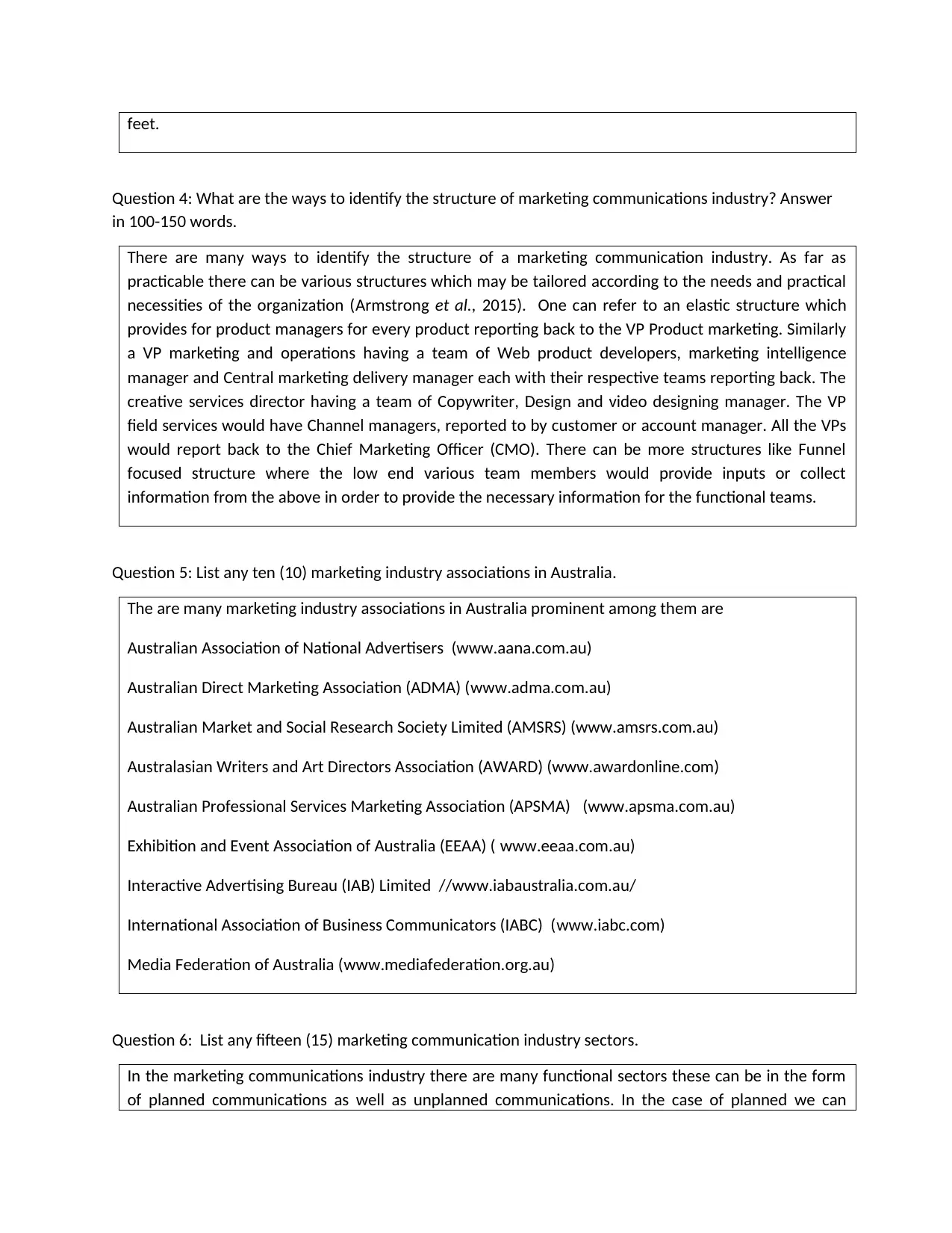
feet.
Question 4: What are the ways to identify the structure of marketing communications industry? Answer
in 100-150 words.
There are many ways to identify the structure of a marketing communication industry. As far as
practicable there can be various structures which may be tailored according to the needs and practical
necessities of the organization (Armstrong et al., 2015). One can refer to an elastic structure which
provides for product managers for every product reporting back to the VP Product marketing. Similarly
a VP marketing and operations having a team of Web product developers, marketing intelligence
manager and Central marketing delivery manager each with their respective teams reporting back. The
creative services director having a team of Copywriter, Design and video designing manager. The VP
field services would have Channel managers, reported to by customer or account manager. All the VPs
would report back to the Chief Marketing Officer (CMO). There can be more structures like Funnel
focused structure where the low end various team members would provide inputs or collect
information from the above in order to provide the necessary information for the functional teams.
Question 5: List any ten (10) marketing industry associations in Australia.
The are many marketing industry associations in Australia prominent among them are
Australian Association of National Advertisers (www.aana.com.au)
Australian Direct Marketing Association (ADMA) (www.adma.com.au)
Australian Market and Social Research Society Limited (AMSRS) (www.amsrs.com.au)
Australasian Writers and Art Directors Association (AWARD) (www.awardonline.com)
Australian Professional Services Marketing Association (APSMA) (www.apsma.com.au)
Exhibition and Event Association of Australia (EEAA) ( www.eeaa.com.au)
Interactive Advertising Bureau (IAB) Limited //www.iabaustralia.com.au/
International Association of Business Communicators (IABC) (www.iabc.com)
Media Federation of Australia (www.mediafederation.org.au)
Question 6: List any fifteen (15) marketing communication industry sectors.
In the marketing communications industry there are many functional sectors these can be in the form
of planned communications as well as unplanned communications. In the case of planned we can
Question 4: What are the ways to identify the structure of marketing communications industry? Answer
in 100-150 words.
There are many ways to identify the structure of a marketing communication industry. As far as
practicable there can be various structures which may be tailored according to the needs and practical
necessities of the organization (Armstrong et al., 2015). One can refer to an elastic structure which
provides for product managers for every product reporting back to the VP Product marketing. Similarly
a VP marketing and operations having a team of Web product developers, marketing intelligence
manager and Central marketing delivery manager each with their respective teams reporting back. The
creative services director having a team of Copywriter, Design and video designing manager. The VP
field services would have Channel managers, reported to by customer or account manager. All the VPs
would report back to the Chief Marketing Officer (CMO). There can be more structures like Funnel
focused structure where the low end various team members would provide inputs or collect
information from the above in order to provide the necessary information for the functional teams.
Question 5: List any ten (10) marketing industry associations in Australia.
The are many marketing industry associations in Australia prominent among them are
Australian Association of National Advertisers (www.aana.com.au)
Australian Direct Marketing Association (ADMA) (www.adma.com.au)
Australian Market and Social Research Society Limited (AMSRS) (www.amsrs.com.au)
Australasian Writers and Art Directors Association (AWARD) (www.awardonline.com)
Australian Professional Services Marketing Association (APSMA) (www.apsma.com.au)
Exhibition and Event Association of Australia (EEAA) ( www.eeaa.com.au)
Interactive Advertising Bureau (IAB) Limited //www.iabaustralia.com.au/
International Association of Business Communicators (IABC) (www.iabc.com)
Media Federation of Australia (www.mediafederation.org.au)
Question 6: List any fifteen (15) marketing communication industry sectors.
In the marketing communications industry there are many functional sectors these can be in the form
of planned communications as well as unplanned communications. In the case of planned we can
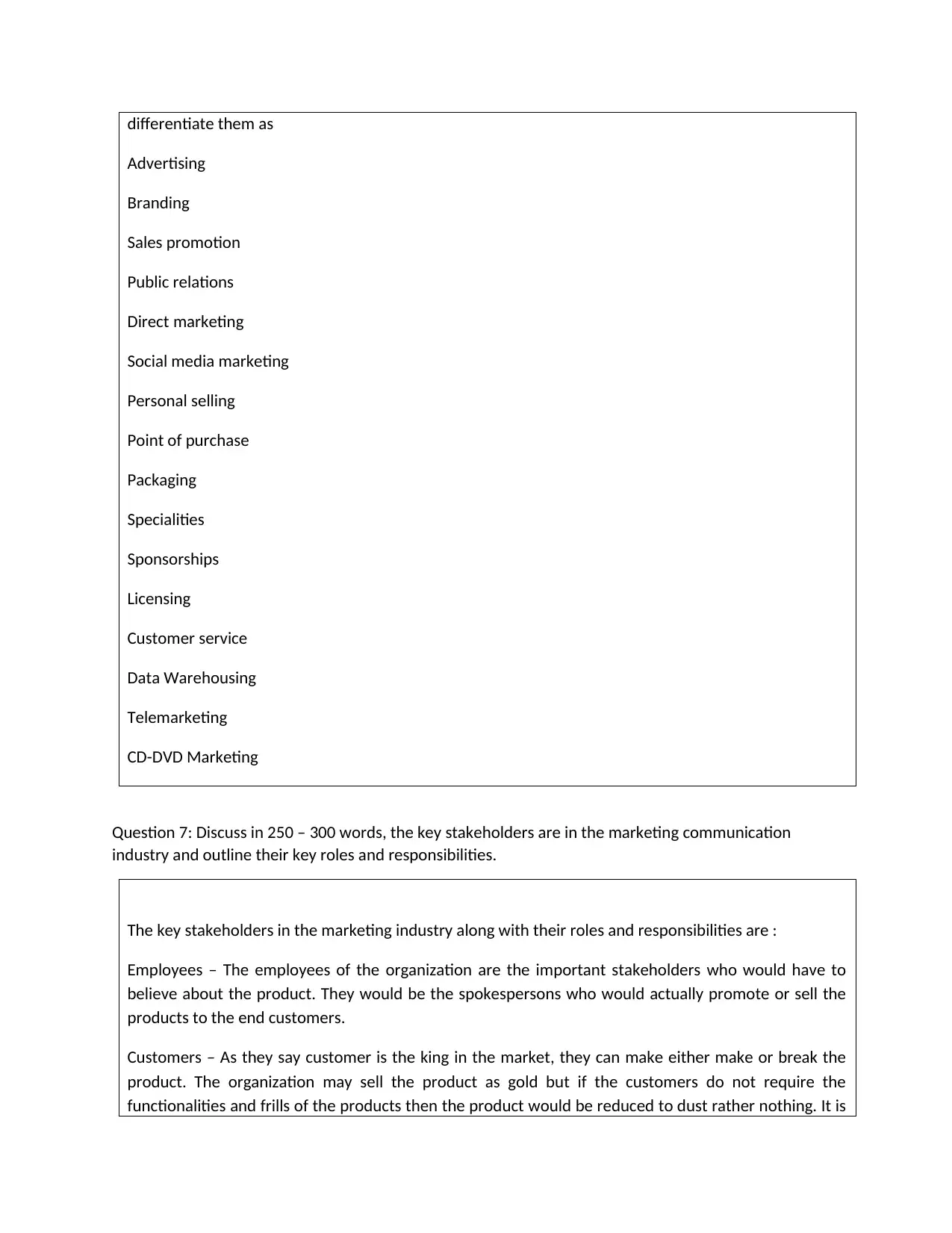
differentiate them as
Advertising
Branding
Sales promotion
Public relations
Direct marketing
Social media marketing
Personal selling
Point of purchase
Packaging
Specialities
Sponsorships
Licensing
Customer service
Data Warehousing
Telemarketing
CD-DVD Marketing
Question 7: Discuss in 250 – 300 words, the key stakeholders are in the marketing communication
industry and outline their key roles and responsibilities.
The key stakeholders in the marketing industry along with their roles and responsibilities are :
Employees – The employees of the organization are the important stakeholders who would have to
believe about the product. They would be the spokespersons who would actually promote or sell the
products to the end customers.
Customers – As they say customer is the king in the market, they can make either make or break the
product. The organization may sell the product as gold but if the customers do not require the
functionalities and frills of the products then the product would be reduced to dust rather nothing. It is
Advertising
Branding
Sales promotion
Public relations
Direct marketing
Social media marketing
Personal selling
Point of purchase
Packaging
Specialities
Sponsorships
Licensing
Customer service
Data Warehousing
Telemarketing
CD-DVD Marketing
Question 7: Discuss in 250 – 300 words, the key stakeholders are in the marketing communication
industry and outline their key roles and responsibilities.
The key stakeholders in the marketing industry along with their roles and responsibilities are :
Employees – The employees of the organization are the important stakeholders who would have to
believe about the product. They would be the spokespersons who would actually promote or sell the
products to the end customers.
Customers – As they say customer is the king in the market, they can make either make or break the
product. The organization may sell the product as gold but if the customers do not require the
functionalities and frills of the products then the product would be reduced to dust rather nothing. It is
⊘ This is a preview!⊘
Do you want full access?
Subscribe today to unlock all pages.

Trusted by 1+ million students worldwide
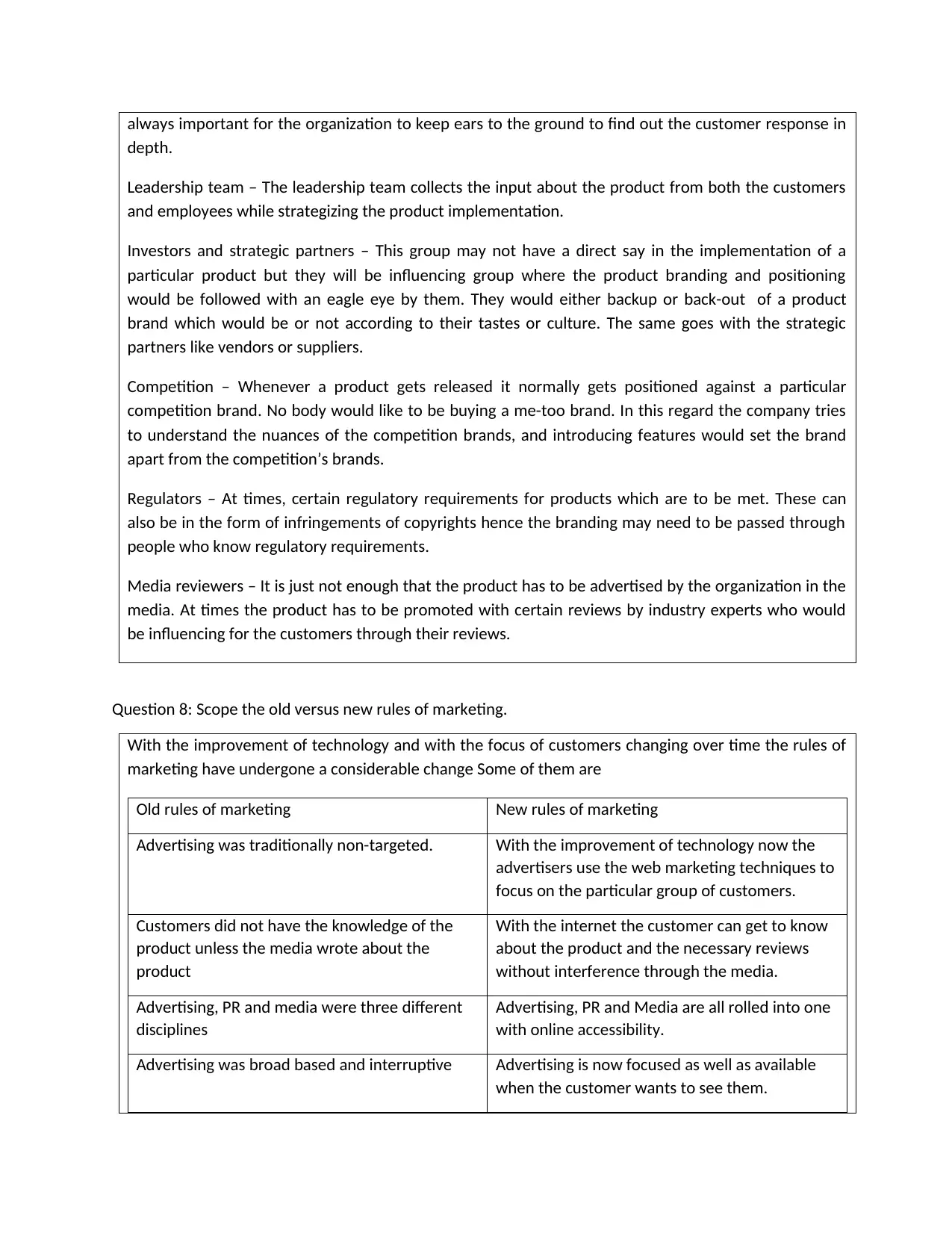
always important for the organization to keep ears to the ground to find out the customer response in
depth.
Leadership team – The leadership team collects the input about the product from both the customers
and employees while strategizing the product implementation.
Investors and strategic partners – This group may not have a direct say in the implementation of a
particular product but they will be influencing group where the product branding and positioning
would be followed with an eagle eye by them. They would either backup or back-out of a product
brand which would be or not according to their tastes or culture. The same goes with the strategic
partners like vendors or suppliers.
Competition – Whenever a product gets released it normally gets positioned against a particular
competition brand. No body would like to be buying a me-too brand. In this regard the company tries
to understand the nuances of the competition brands, and introducing features would set the brand
apart from the competition’s brands.
Regulators – At times, certain regulatory requirements for products which are to be met. These can
also be in the form of infringements of copyrights hence the branding may need to be passed through
people who know regulatory requirements.
Media reviewers – It is just not enough that the product has to be advertised by the organization in the
media. At times the product has to be promoted with certain reviews by industry experts who would
be influencing for the customers through their reviews.
Question 8: Scope the old versus new rules of marketing.
With the improvement of technology and with the focus of customers changing over time the rules of
marketing have undergone a considerable change Some of them are
Old rules of marketing New rules of marketing
Advertising was traditionally non-targeted. With the improvement of technology now the
advertisers use the web marketing techniques to
focus on the particular group of customers.
Customers did not have the knowledge of the
product unless the media wrote about the
product
With the internet the customer can get to know
about the product and the necessary reviews
without interference through the media.
Advertising, PR and media were three different
disciplines
Advertising, PR and Media are all rolled into one
with online accessibility.
Advertising was broad based and interruptive Advertising is now focused as well as available
when the customer wants to see them.
depth.
Leadership team – The leadership team collects the input about the product from both the customers
and employees while strategizing the product implementation.
Investors and strategic partners – This group may not have a direct say in the implementation of a
particular product but they will be influencing group where the product branding and positioning
would be followed with an eagle eye by them. They would either backup or back-out of a product
brand which would be or not according to their tastes or culture. The same goes with the strategic
partners like vendors or suppliers.
Competition – Whenever a product gets released it normally gets positioned against a particular
competition brand. No body would like to be buying a me-too brand. In this regard the company tries
to understand the nuances of the competition brands, and introducing features would set the brand
apart from the competition’s brands.
Regulators – At times, certain regulatory requirements for products which are to be met. These can
also be in the form of infringements of copyrights hence the branding may need to be passed through
people who know regulatory requirements.
Media reviewers – It is just not enough that the product has to be advertised by the organization in the
media. At times the product has to be promoted with certain reviews by industry experts who would
be influencing for the customers through their reviews.
Question 8: Scope the old versus new rules of marketing.
With the improvement of technology and with the focus of customers changing over time the rules of
marketing have undergone a considerable change Some of them are
Old rules of marketing New rules of marketing
Advertising was traditionally non-targeted. With the improvement of technology now the
advertisers use the web marketing techniques to
focus on the particular group of customers.
Customers did not have the knowledge of the
product unless the media wrote about the
product
With the internet the customer can get to know
about the product and the necessary reviews
without interference through the media.
Advertising, PR and media were three different
disciplines
Advertising, PR and Media are all rolled into one
with online accessibility.
Advertising was broad based and interruptive Advertising is now focused as well as available
when the customer wants to see them.
Paraphrase This Document
Need a fresh take? Get an instant paraphrase of this document with our AI Paraphraser
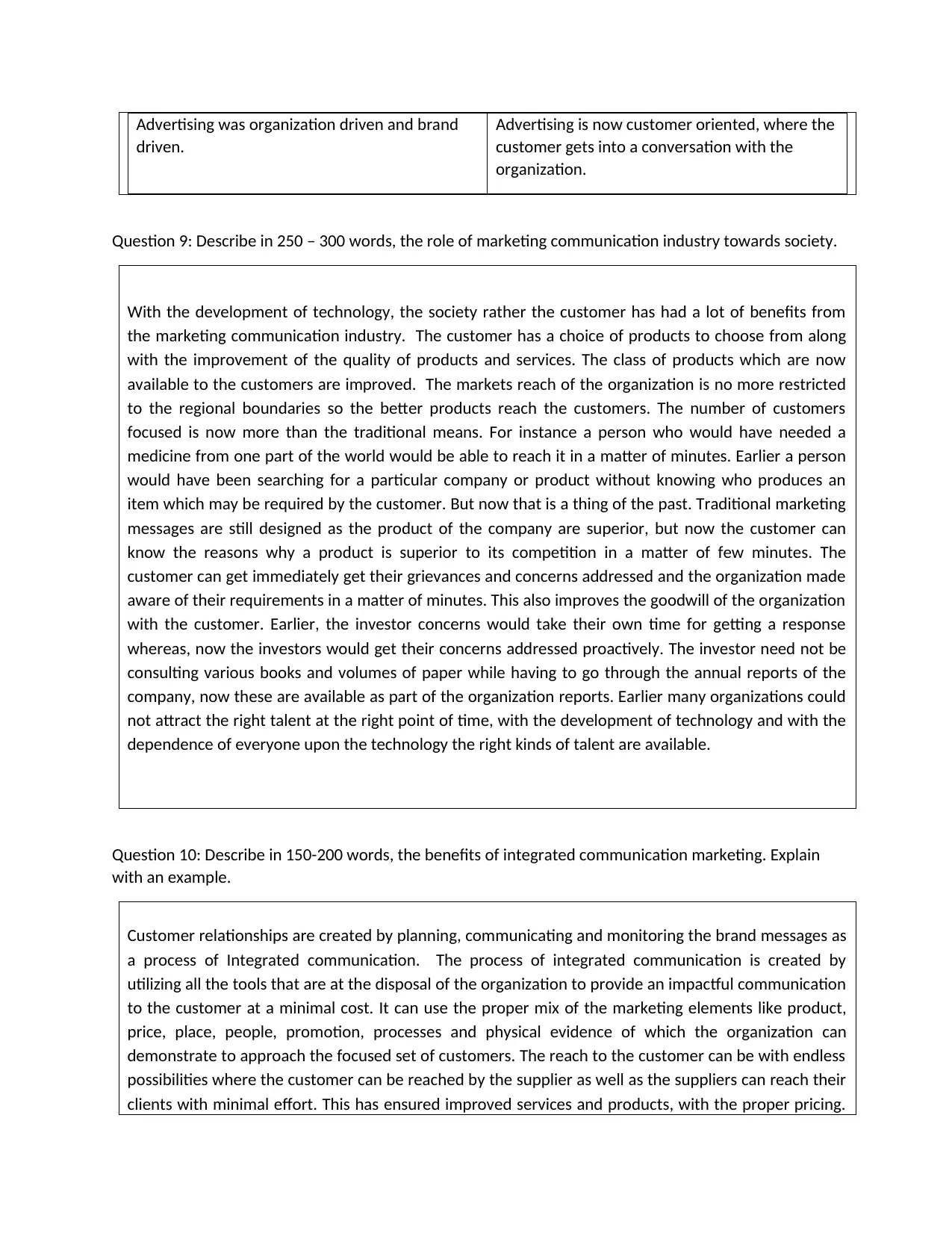
Advertising was organization driven and brand
driven.
Advertising is now customer oriented, where the
customer gets into a conversation with the
organization.
Question 9: Describe in 250 – 300 words, the role of marketing communication industry towards society.
With the development of technology, the society rather the customer has had a lot of benefits from
the marketing communication industry. The customer has a choice of products to choose from along
with the improvement of the quality of products and services. The class of products which are now
available to the customers are improved. The markets reach of the organization is no more restricted
to the regional boundaries so the better products reach the customers. The number of customers
focused is now more than the traditional means. For instance a person who would have needed a
medicine from one part of the world would be able to reach it in a matter of minutes. Earlier a person
would have been searching for a particular company or product without knowing who produces an
item which may be required by the customer. But now that is a thing of the past. Traditional marketing
messages are still designed as the product of the company are superior, but now the customer can
know the reasons why a product is superior to its competition in a matter of few minutes. The
customer can get immediately get their grievances and concerns addressed and the organization made
aware of their requirements in a matter of minutes. This also improves the goodwill of the organization
with the customer. Earlier, the investor concerns would take their own time for getting a response
whereas, now the investors would get their concerns addressed proactively. The investor need not be
consulting various books and volumes of paper while having to go through the annual reports of the
company, now these are available as part of the organization reports. Earlier many organizations could
not attract the right talent at the right point of time, with the development of technology and with the
dependence of everyone upon the technology the right kinds of talent are available.
Question 10: Describe in 150-200 words, the benefits of integrated communication marketing. Explain
with an example.
Customer relationships are created by planning, communicating and monitoring the brand messages as
a process of Integrated communication. The process of integrated communication is created by
utilizing all the tools that are at the disposal of the organization to provide an impactful communication
to the customer at a minimal cost. It can use the proper mix of the marketing elements like product,
price, place, people, promotion, processes and physical evidence of which the organization can
demonstrate to approach the focused set of customers. The reach to the customer can be with endless
possibilities where the customer can be reached by the supplier as well as the suppliers can reach their
clients with minimal effort. This has ensured improved services and products, with the proper pricing.
driven.
Advertising is now customer oriented, where the
customer gets into a conversation with the
organization.
Question 9: Describe in 250 – 300 words, the role of marketing communication industry towards society.
With the development of technology, the society rather the customer has had a lot of benefits from
the marketing communication industry. The customer has a choice of products to choose from along
with the improvement of the quality of products and services. The class of products which are now
available to the customers are improved. The markets reach of the organization is no more restricted
to the regional boundaries so the better products reach the customers. The number of customers
focused is now more than the traditional means. For instance a person who would have needed a
medicine from one part of the world would be able to reach it in a matter of minutes. Earlier a person
would have been searching for a particular company or product without knowing who produces an
item which may be required by the customer. But now that is a thing of the past. Traditional marketing
messages are still designed as the product of the company are superior, but now the customer can
know the reasons why a product is superior to its competition in a matter of few minutes. The
customer can get immediately get their grievances and concerns addressed and the organization made
aware of their requirements in a matter of minutes. This also improves the goodwill of the organization
with the customer. Earlier, the investor concerns would take their own time for getting a response
whereas, now the investors would get their concerns addressed proactively. The investor need not be
consulting various books and volumes of paper while having to go through the annual reports of the
company, now these are available as part of the organization reports. Earlier many organizations could
not attract the right talent at the right point of time, with the development of technology and with the
dependence of everyone upon the technology the right kinds of talent are available.
Question 10: Describe in 150-200 words, the benefits of integrated communication marketing. Explain
with an example.
Customer relationships are created by planning, communicating and monitoring the brand messages as
a process of Integrated communication. The process of integrated communication is created by
utilizing all the tools that are at the disposal of the organization to provide an impactful communication
to the customer at a minimal cost. It can use the proper mix of the marketing elements like product,
price, place, people, promotion, processes and physical evidence of which the organization can
demonstrate to approach the focused set of customers. The reach to the customer can be with endless
possibilities where the customer can be reached by the supplier as well as the suppliers can reach their
clients with minimal effort. This has ensured improved services and products, with the proper pricing.
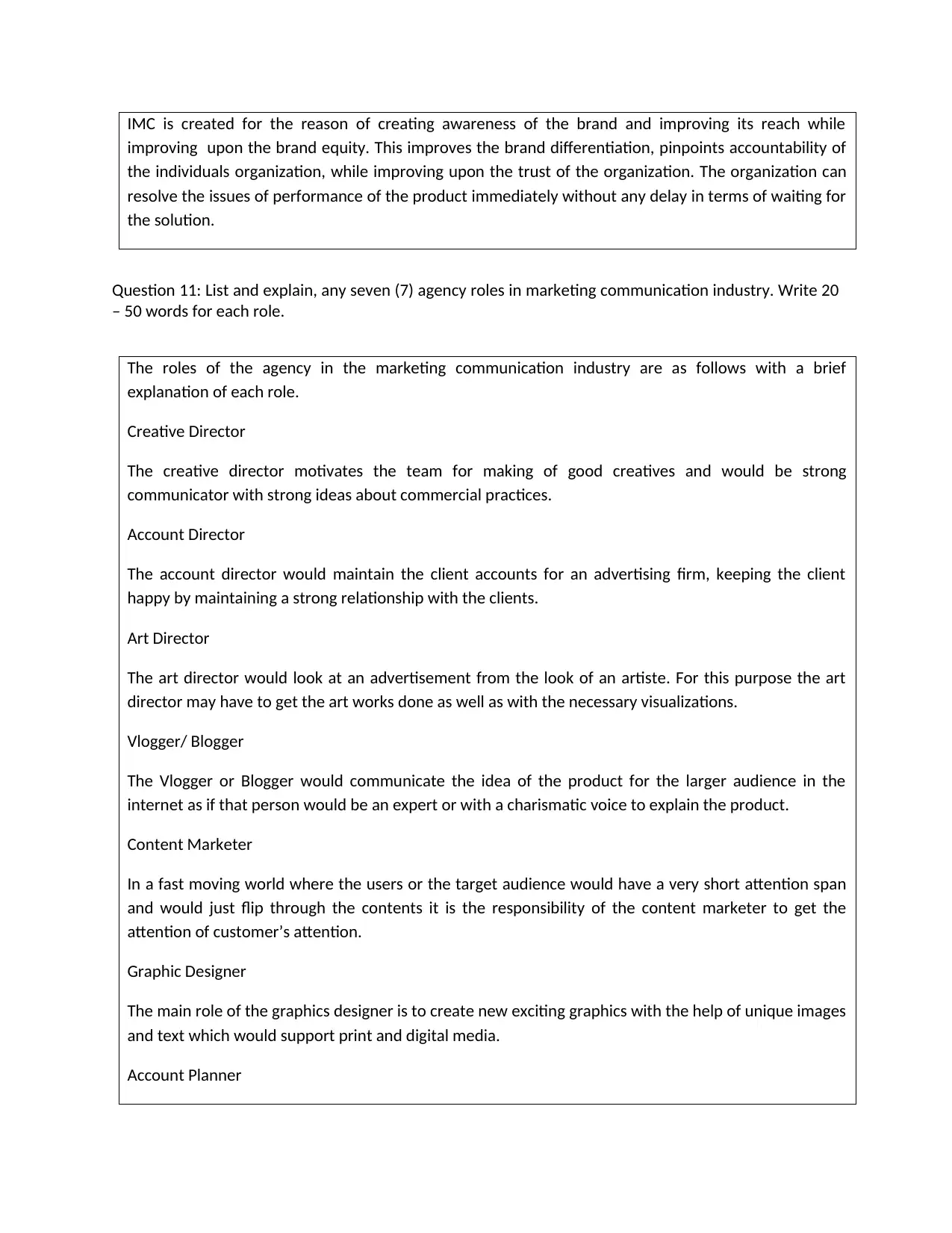
IMC is created for the reason of creating awareness of the brand and improving its reach while
improving upon the brand equity. This improves the brand differentiation, pinpoints accountability of
the individuals organization, while improving upon the trust of the organization. The organization can
resolve the issues of performance of the product immediately without any delay in terms of waiting for
the solution.
Question 11: List and explain, any seven (7) agency roles in marketing communication industry. Write 20
– 50 words for each role.
The roles of the agency in the marketing communication industry are as follows with a brief
explanation of each role.
Creative Director
The creative director motivates the team for making of good creatives and would be strong
communicator with strong ideas about commercial practices.
Account Director
The account director would maintain the client accounts for an advertising firm, keeping the client
happy by maintaining a strong relationship with the clients.
Art Director
The art director would look at an advertisement from the look of an artiste. For this purpose the art
director may have to get the art works done as well as with the necessary visualizations.
Vlogger/ Blogger
The Vlogger or Blogger would communicate the idea of the product for the larger audience in the
internet as if that person would be an expert or with a charismatic voice to explain the product.
Content Marketer
In a fast moving world where the users or the target audience would have a very short attention span
and would just flip through the contents it is the responsibility of the content marketer to get the
attention of customer’s attention.
Graphic Designer
The main role of the graphics designer is to create new exciting graphics with the help of unique images
and text which would support print and digital media.
Account Planner
improving upon the brand equity. This improves the brand differentiation, pinpoints accountability of
the individuals organization, while improving upon the trust of the organization. The organization can
resolve the issues of performance of the product immediately without any delay in terms of waiting for
the solution.
Question 11: List and explain, any seven (7) agency roles in marketing communication industry. Write 20
– 50 words for each role.
The roles of the agency in the marketing communication industry are as follows with a brief
explanation of each role.
Creative Director
The creative director motivates the team for making of good creatives and would be strong
communicator with strong ideas about commercial practices.
Account Director
The account director would maintain the client accounts for an advertising firm, keeping the client
happy by maintaining a strong relationship with the clients.
Art Director
The art director would look at an advertisement from the look of an artiste. For this purpose the art
director may have to get the art works done as well as with the necessary visualizations.
Vlogger/ Blogger
The Vlogger or Blogger would communicate the idea of the product for the larger audience in the
internet as if that person would be an expert or with a charismatic voice to explain the product.
Content Marketer
In a fast moving world where the users or the target audience would have a very short attention span
and would just flip through the contents it is the responsibility of the content marketer to get the
attention of customer’s attention.
Graphic Designer
The main role of the graphics designer is to create new exciting graphics with the help of unique images
and text which would support print and digital media.
Account Planner
⊘ This is a preview!⊘
Do you want full access?
Subscribe today to unlock all pages.

Trusted by 1+ million students worldwide
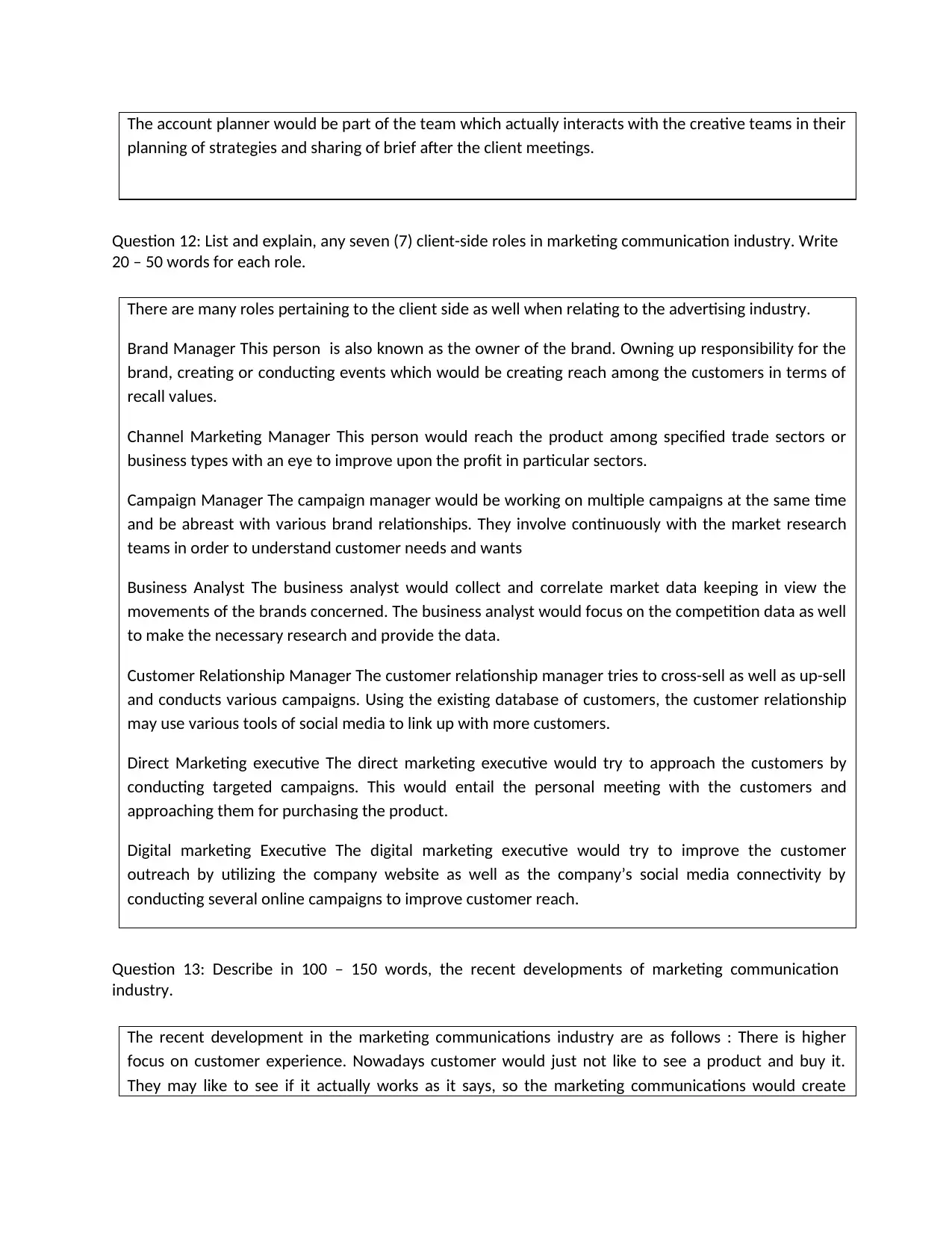
The account planner would be part of the team which actually interacts with the creative teams in their
planning of strategies and sharing of brief after the client meetings.
Question 12: List and explain, any seven (7) client-side roles in marketing communication industry. Write
20 – 50 words for each role.
There are many roles pertaining to the client side as well when relating to the advertising industry.
Brand Manager This person is also known as the owner of the brand. Owning up responsibility for the
brand, creating or conducting events which would be creating reach among the customers in terms of
recall values.
Channel Marketing Manager This person would reach the product among specified trade sectors or
business types with an eye to improve upon the profit in particular sectors.
Campaign Manager The campaign manager would be working on multiple campaigns at the same time
and be abreast with various brand relationships. They involve continuously with the market research
teams in order to understand customer needs and wants
Business Analyst The business analyst would collect and correlate market data keeping in view the
movements of the brands concerned. The business analyst would focus on the competition data as well
to make the necessary research and provide the data.
Customer Relationship Manager The customer relationship manager tries to cross-sell as well as up-sell
and conducts various campaigns. Using the existing database of customers, the customer relationship
may use various tools of social media to link up with more customers.
Direct Marketing executive The direct marketing executive would try to approach the customers by
conducting targeted campaigns. This would entail the personal meeting with the customers and
approaching them for purchasing the product.
Digital marketing Executive The digital marketing executive would try to improve the customer
outreach by utilizing the company website as well as the company’s social media connectivity by
conducting several online campaigns to improve customer reach.
Question 13: Describe in 100 – 150 words, the recent developments of marketing communication
industry.
The recent development in the marketing communications industry are as follows : There is higher
focus on customer experience. Nowadays customer would just not like to see a product and buy it.
They may like to see if it actually works as it says, so the marketing communications would create
planning of strategies and sharing of brief after the client meetings.
Question 12: List and explain, any seven (7) client-side roles in marketing communication industry. Write
20 – 50 words for each role.
There are many roles pertaining to the client side as well when relating to the advertising industry.
Brand Manager This person is also known as the owner of the brand. Owning up responsibility for the
brand, creating or conducting events which would be creating reach among the customers in terms of
recall values.
Channel Marketing Manager This person would reach the product among specified trade sectors or
business types with an eye to improve upon the profit in particular sectors.
Campaign Manager The campaign manager would be working on multiple campaigns at the same time
and be abreast with various brand relationships. They involve continuously with the market research
teams in order to understand customer needs and wants
Business Analyst The business analyst would collect and correlate market data keeping in view the
movements of the brands concerned. The business analyst would focus on the competition data as well
to make the necessary research and provide the data.
Customer Relationship Manager The customer relationship manager tries to cross-sell as well as up-sell
and conducts various campaigns. Using the existing database of customers, the customer relationship
may use various tools of social media to link up with more customers.
Direct Marketing executive The direct marketing executive would try to approach the customers by
conducting targeted campaigns. This would entail the personal meeting with the customers and
approaching them for purchasing the product.
Digital marketing Executive The digital marketing executive would try to improve the customer
outreach by utilizing the company website as well as the company’s social media connectivity by
conducting several online campaigns to improve customer reach.
Question 13: Describe in 100 – 150 words, the recent developments of marketing communication
industry.
The recent development in the marketing communications industry are as follows : There is higher
focus on customer experience. Nowadays customer would just not like to see a product and buy it.
They may like to see if it actually works as it says, so the marketing communications would create
Paraphrase This Document
Need a fresh take? Get an instant paraphrase of this document with our AI Paraphraser
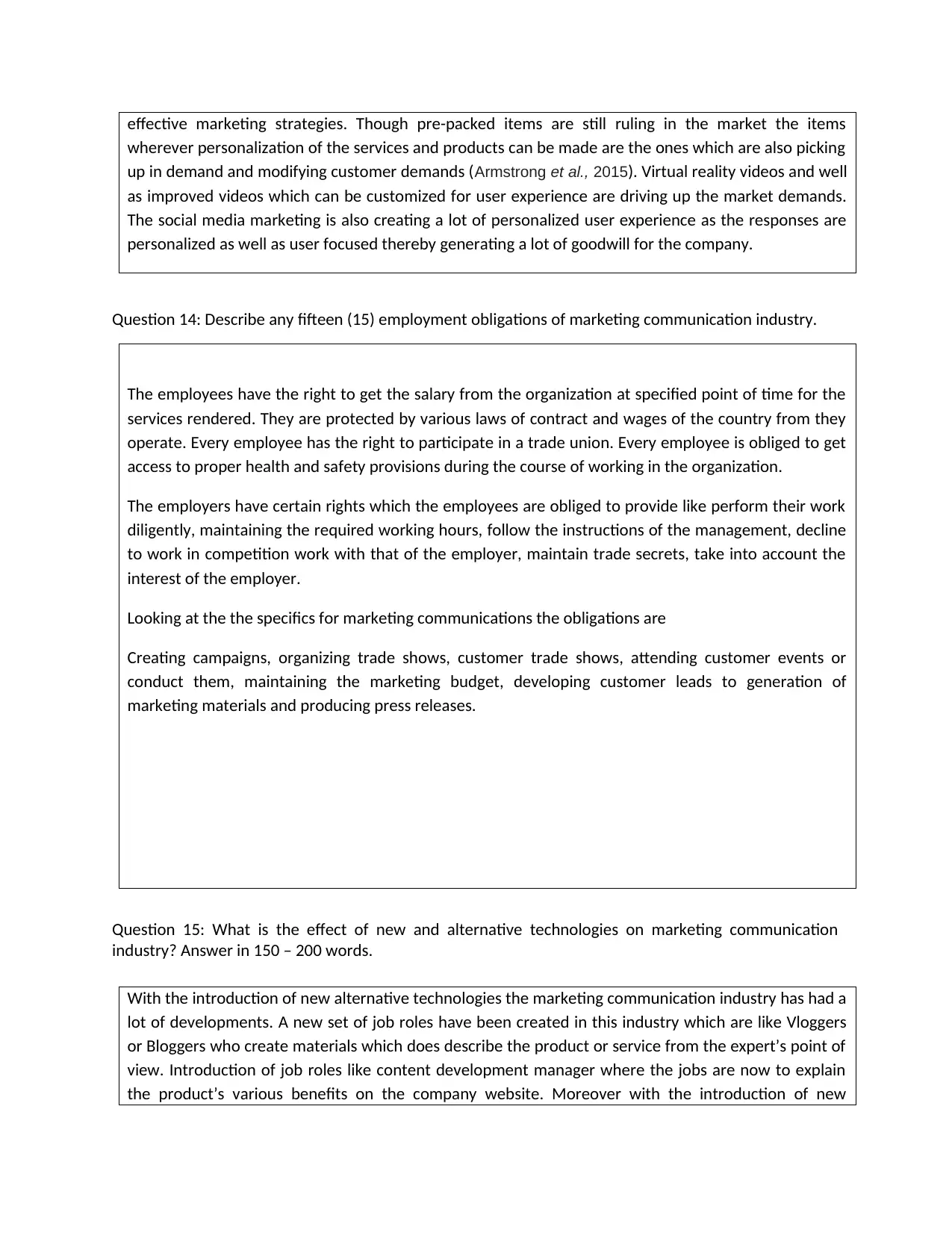
effective marketing strategies. Though pre-packed items are still ruling in the market the items
wherever personalization of the services and products can be made are the ones which are also picking
up in demand and modifying customer demands (Armstrong et al., 2015). Virtual reality videos and well
as improved videos which can be customized for user experience are driving up the market demands.
The social media marketing is also creating a lot of personalized user experience as the responses are
personalized as well as user focused thereby generating a lot of goodwill for the company.
Question 14: Describe any fifteen (15) employment obligations of marketing communication industry.
The employees have the right to get the salary from the organization at specified point of time for the
services rendered. They are protected by various laws of contract and wages of the country from they
operate. Every employee has the right to participate in a trade union. Every employee is obliged to get
access to proper health and safety provisions during the course of working in the organization.
The employers have certain rights which the employees are obliged to provide like perform their work
diligently, maintaining the required working hours, follow the instructions of the management, decline
to work in competition work with that of the employer, maintain trade secrets, take into account the
interest of the employer.
Looking at the the specifics for marketing communications the obligations are
Creating campaigns, organizing trade shows, customer trade shows, attending customer events or
conduct them, maintaining the marketing budget, developing customer leads to generation of
marketing materials and producing press releases.
Question 15: What is the effect of new and alternative technologies on marketing communication
industry? Answer in 150 – 200 words.
With the introduction of new alternative technologies the marketing communication industry has had a
lot of developments. A new set of job roles have been created in this industry which are like Vloggers
or Bloggers who create materials which does describe the product or service from the expert’s point of
view. Introduction of job roles like content development manager where the jobs are now to explain
the product’s various benefits on the company website. Moreover with the introduction of new
wherever personalization of the services and products can be made are the ones which are also picking
up in demand and modifying customer demands (Armstrong et al., 2015). Virtual reality videos and well
as improved videos which can be customized for user experience are driving up the market demands.
The social media marketing is also creating a lot of personalized user experience as the responses are
personalized as well as user focused thereby generating a lot of goodwill for the company.
Question 14: Describe any fifteen (15) employment obligations of marketing communication industry.
The employees have the right to get the salary from the organization at specified point of time for the
services rendered. They are protected by various laws of contract and wages of the country from they
operate. Every employee has the right to participate in a trade union. Every employee is obliged to get
access to proper health and safety provisions during the course of working in the organization.
The employers have certain rights which the employees are obliged to provide like perform their work
diligently, maintaining the required working hours, follow the instructions of the management, decline
to work in competition work with that of the employer, maintain trade secrets, take into account the
interest of the employer.
Looking at the the specifics for marketing communications the obligations are
Creating campaigns, organizing trade shows, customer trade shows, attending customer events or
conduct them, maintaining the marketing budget, developing customer leads to generation of
marketing materials and producing press releases.
Question 15: What is the effect of new and alternative technologies on marketing communication
industry? Answer in 150 – 200 words.
With the introduction of new alternative technologies the marketing communication industry has had a
lot of developments. A new set of job roles have been created in this industry which are like Vloggers
or Bloggers who create materials which does describe the product or service from the expert’s point of
view. Introduction of job roles like content development manager where the jobs are now to explain
the product’s various benefits on the company website. Moreover with the introduction of new
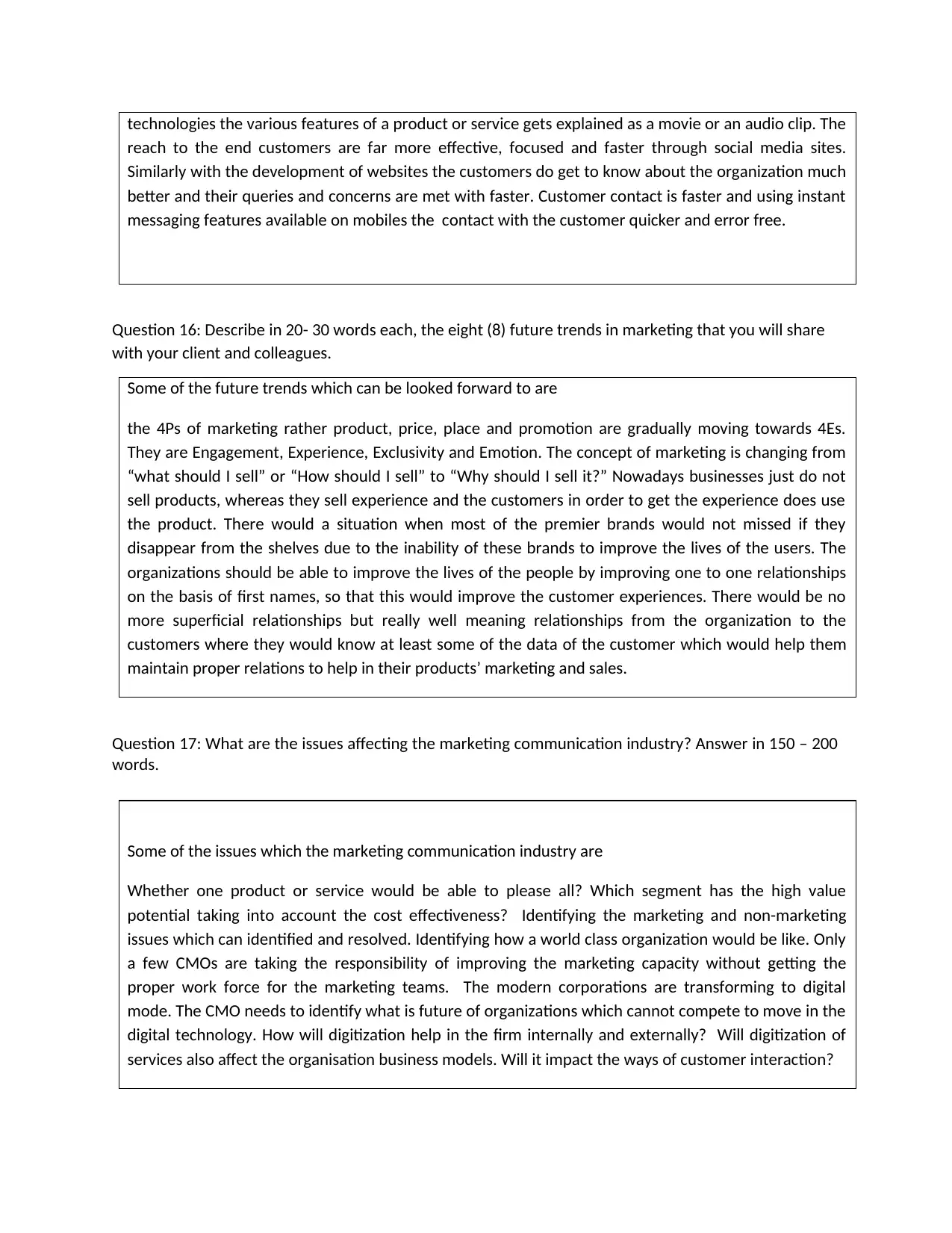
technologies the various features of a product or service gets explained as a movie or an audio clip. The
reach to the end customers are far more effective, focused and faster through social media sites.
Similarly with the development of websites the customers do get to know about the organization much
better and their queries and concerns are met with faster. Customer contact is faster and using instant
messaging features available on mobiles the contact with the customer quicker and error free.
Question 16: Describe in 20- 30 words each, the eight (8) future trends in marketing that you will share
with your client and colleagues.
Some of the future trends which can be looked forward to are
the 4Ps of marketing rather product, price, place and promotion are gradually moving towards 4Es.
They are Engagement, Experience, Exclusivity and Emotion. The concept of marketing is changing from
“what should I sell” or “How should I sell” to “Why should I sell it?” Nowadays businesses just do not
sell products, whereas they sell experience and the customers in order to get the experience does use
the product. There would a situation when most of the premier brands would not missed if they
disappear from the shelves due to the inability of these brands to improve the lives of the users. The
organizations should be able to improve the lives of the people by improving one to one relationships
on the basis of first names, so that this would improve the customer experiences. There would be no
more superficial relationships but really well meaning relationships from the organization to the
customers where they would know at least some of the data of the customer which would help them
maintain proper relations to help in their products’ marketing and sales.
Question 17: What are the issues affecting the marketing communication industry? Answer in 150 – 200
words.
Some of the issues which the marketing communication industry are
Whether one product or service would be able to please all? Which segment has the high value
potential taking into account the cost effectiveness? Identifying the marketing and non-marketing
issues which can identified and resolved. Identifying how a world class organization would be like. Only
a few CMOs are taking the responsibility of improving the marketing capacity without getting the
proper work force for the marketing teams. The modern corporations are transforming to digital
mode. The CMO needs to identify what is future of organizations which cannot compete to move in the
digital technology. How will digitization help in the firm internally and externally? Will digitization of
services also affect the organisation business models. Will it impact the ways of customer interaction?
reach to the end customers are far more effective, focused and faster through social media sites.
Similarly with the development of websites the customers do get to know about the organization much
better and their queries and concerns are met with faster. Customer contact is faster and using instant
messaging features available on mobiles the contact with the customer quicker and error free.
Question 16: Describe in 20- 30 words each, the eight (8) future trends in marketing that you will share
with your client and colleagues.
Some of the future trends which can be looked forward to are
the 4Ps of marketing rather product, price, place and promotion are gradually moving towards 4Es.
They are Engagement, Experience, Exclusivity and Emotion. The concept of marketing is changing from
“what should I sell” or “How should I sell” to “Why should I sell it?” Nowadays businesses just do not
sell products, whereas they sell experience and the customers in order to get the experience does use
the product. There would a situation when most of the premier brands would not missed if they
disappear from the shelves due to the inability of these brands to improve the lives of the users. The
organizations should be able to improve the lives of the people by improving one to one relationships
on the basis of first names, so that this would improve the customer experiences. There would be no
more superficial relationships but really well meaning relationships from the organization to the
customers where they would know at least some of the data of the customer which would help them
maintain proper relations to help in their products’ marketing and sales.
Question 17: What are the issues affecting the marketing communication industry? Answer in 150 – 200
words.
Some of the issues which the marketing communication industry are
Whether one product or service would be able to please all? Which segment has the high value
potential taking into account the cost effectiveness? Identifying the marketing and non-marketing
issues which can identified and resolved. Identifying how a world class organization would be like. Only
a few CMOs are taking the responsibility of improving the marketing capacity without getting the
proper work force for the marketing teams. The modern corporations are transforming to digital
mode. The CMO needs to identify what is future of organizations which cannot compete to move in the
digital technology. How will digitization help in the firm internally and externally? Will digitization of
services also affect the organisation business models. Will it impact the ways of customer interaction?
⊘ This is a preview!⊘
Do you want full access?
Subscribe today to unlock all pages.

Trusted by 1+ million students worldwide
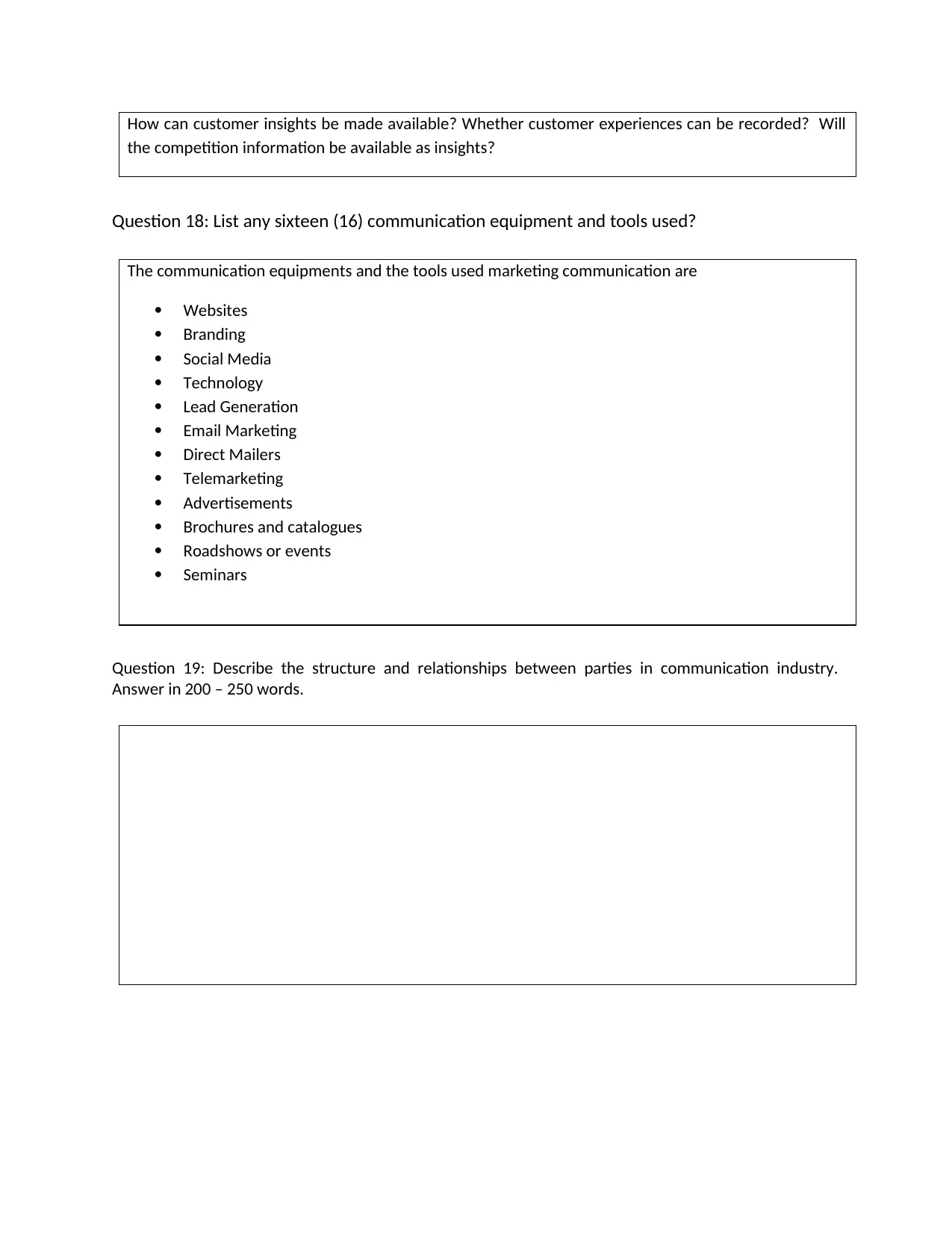
How can customer insights be made available? Whether customer experiences can be recorded? Will
the competition information be available as insights?
Question 18: List any sixteen (16) communication equipment and tools used?
The communication equipments and the tools used marketing communication are
Websites
Branding
Social Media
Technology
Lead Generation
Email Marketing
Direct Mailers
Telemarketing
Advertisements
Brochures and catalogues
Roadshows or events
Seminars
Question 19: Describe the structure and relationships between parties in communication industry.
Answer in 200 – 250 words.
the competition information be available as insights?
Question 18: List any sixteen (16) communication equipment and tools used?
The communication equipments and the tools used marketing communication are
Websites
Branding
Social Media
Technology
Lead Generation
Email Marketing
Direct Mailers
Telemarketing
Advertisements
Brochures and catalogues
Roadshows or events
Seminars
Question 19: Describe the structure and relationships between parties in communication industry.
Answer in 200 – 250 words.
Paraphrase This Document
Need a fresh take? Get an instant paraphrase of this document with our AI Paraphraser
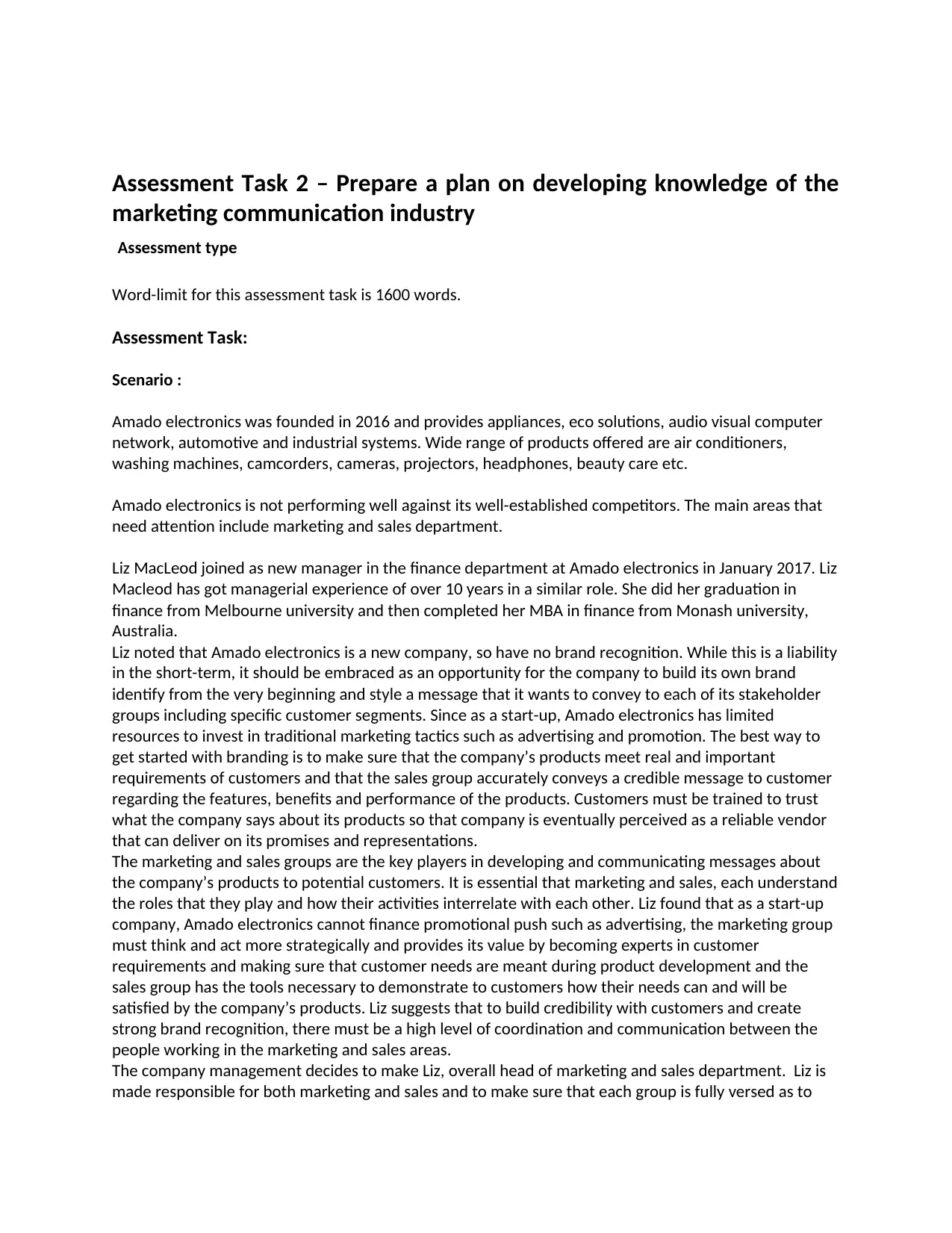
Assessment Task 2 – Prepare a plan on developing knowledge of the
marketing communication industry
Assessment type
Word-limit for this assessment task is 1600 words.
Assessment Task:
Scenario :
Amado electronics was founded in 2016 and provides appliances, eco solutions, audio visual computer
network, automotive and industrial systems. Wide range of products offered are air conditioners,
washing machines, camcorders, cameras, projectors, headphones, beauty care etc.
Amado electronics is not performing well against its well-established competitors. The main areas that
need attention include marketing and sales department.
Liz MacLeod joined as new manager in the finance department at Amado electronics in January 2017. Liz
Macleod has got managerial experience of over 10 years in a similar role. She did her graduation in
finance from Melbourne university and then completed her MBA in finance from Monash university,
Australia.
Liz noted that Amado electronics is a new company, so have no brand recognition. While this is a liability
in the short-term, it should be embraced as an opportunity for the company to build its own brand
identify from the very beginning and style a message that it wants to convey to each of its stakeholder
groups including specific customer segments. Since as a start-up, Amado electronics has limited
resources to invest in traditional marketing tactics such as advertising and promotion. The best way to
get started with branding is to make sure that the company’s products meet real and important
requirements of customers and that the sales group accurately conveys a credible message to customer
regarding the features, benefits and performance of the products. Customers must be trained to trust
what the company says about its products so that company is eventually perceived as a reliable vendor
that can deliver on its promises and representations.
The marketing and sales groups are the key players in developing and communicating messages about
the company’s products to potential customers. It is essential that marketing and sales, each understand
the roles that they play and how their activities interrelate with each other. Liz found that as a start-up
company, Amado electronics cannot finance promotional push such as advertising, the marketing group
must think and act more strategically and provides its value by becoming experts in customer
requirements and making sure that customer needs are meant during product development and the
sales group has the tools necessary to demonstrate to customers how their needs can and will be
satisfied by the company’s products. Liz suggests that to build credibility with customers and create
strong brand recognition, there must be a high level of coordination and communication between the
people working in the marketing and sales areas.
The company management decides to make Liz, overall head of marketing and sales department. Liz is
made responsible for both marketing and sales and to make sure that each group is fully versed as to
marketing communication industry
Assessment type
Word-limit for this assessment task is 1600 words.
Assessment Task:
Scenario :
Amado electronics was founded in 2016 and provides appliances, eco solutions, audio visual computer
network, automotive and industrial systems. Wide range of products offered are air conditioners,
washing machines, camcorders, cameras, projectors, headphones, beauty care etc.
Amado electronics is not performing well against its well-established competitors. The main areas that
need attention include marketing and sales department.
Liz MacLeod joined as new manager in the finance department at Amado electronics in January 2017. Liz
Macleod has got managerial experience of over 10 years in a similar role. She did her graduation in
finance from Melbourne university and then completed her MBA in finance from Monash university,
Australia.
Liz noted that Amado electronics is a new company, so have no brand recognition. While this is a liability
in the short-term, it should be embraced as an opportunity for the company to build its own brand
identify from the very beginning and style a message that it wants to convey to each of its stakeholder
groups including specific customer segments. Since as a start-up, Amado electronics has limited
resources to invest in traditional marketing tactics such as advertising and promotion. The best way to
get started with branding is to make sure that the company’s products meet real and important
requirements of customers and that the sales group accurately conveys a credible message to customer
regarding the features, benefits and performance of the products. Customers must be trained to trust
what the company says about its products so that company is eventually perceived as a reliable vendor
that can deliver on its promises and representations.
The marketing and sales groups are the key players in developing and communicating messages about
the company’s products to potential customers. It is essential that marketing and sales, each understand
the roles that they play and how their activities interrelate with each other. Liz found that as a start-up
company, Amado electronics cannot finance promotional push such as advertising, the marketing group
must think and act more strategically and provides its value by becoming experts in customer
requirements and making sure that customer needs are meant during product development and the
sales group has the tools necessary to demonstrate to customers how their needs can and will be
satisfied by the company’s products. Liz suggests that to build credibility with customers and create
strong brand recognition, there must be a high level of coordination and communication between the
people working in the marketing and sales areas.
The company management decides to make Liz, overall head of marketing and sales department. Liz is
made responsible for both marketing and sales and to make sure that each group is fully versed as to
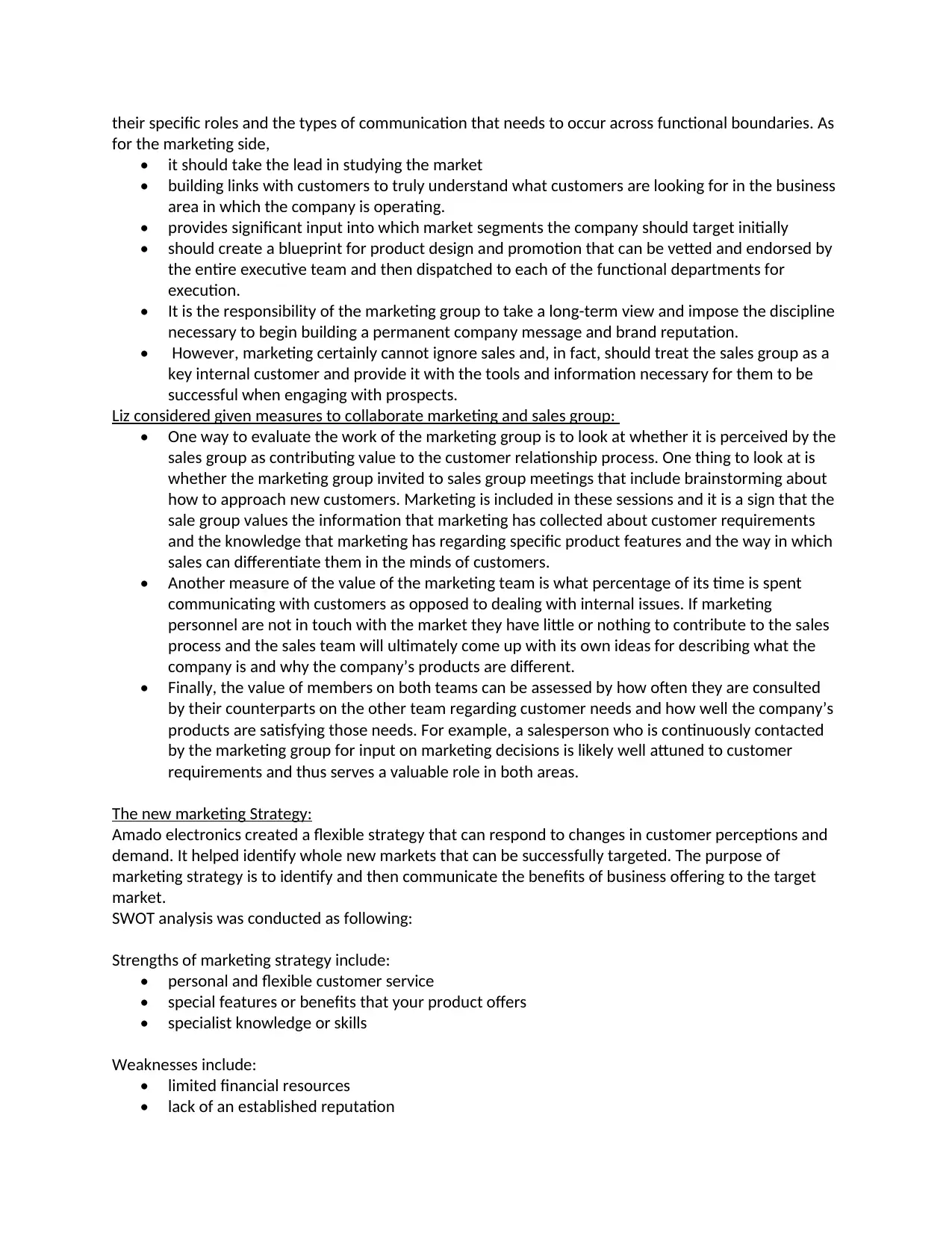
their specific roles and the types of communication that needs to occur across functional boundaries. As
for the marketing side,
• it should take the lead in studying the market
• building links with customers to truly understand what customers are looking for in the business
area in which the company is operating.
• provides significant input into which market segments the company should target initially
• should create a blueprint for product design and promotion that can be vetted and endorsed by
the entire executive team and then dispatched to each of the functional departments for
execution.
• It is the responsibility of the marketing group to take a long-term view and impose the discipline
necessary to begin building a permanent company message and brand reputation.
• However, marketing certainly cannot ignore sales and, in fact, should treat the sales group as a
key internal customer and provide it with the tools and information necessary for them to be
successful when engaging with prospects.
Liz considered given measures to collaborate marketing and sales group:
• One way to evaluate the work of the marketing group is to look at whether it is perceived by the
sales group as contributing value to the customer relationship process. One thing to look at is
whether the marketing group invited to sales group meetings that include brainstorming about
how to approach new customers. Marketing is included in these sessions and it is a sign that the
sale group values the information that marketing has collected about customer requirements
and the knowledge that marketing has regarding specific product features and the way in which
sales can differentiate them in the minds of customers.
• Another measure of the value of the marketing team is what percentage of its time is spent
communicating with customers as opposed to dealing with internal issues. If marketing
personnel are not in touch with the market they have little or nothing to contribute to the sales
process and the sales team will ultimately come up with its own ideas for describing what the
company is and why the company’s products are different.
• Finally, the value of members on both teams can be assessed by how often they are consulted
by their counterparts on the other team regarding customer needs and how well the company’s
products are satisfying those needs. For example, a salesperson who is continuously contacted
by the marketing group for input on marketing decisions is likely well attuned to customer
requirements and thus serves a valuable role in both areas.
The new marketing Strategy:
Amado electronics created a flexible strategy that can respond to changes in customer perceptions and
demand. It helped identify whole new markets that can be successfully targeted. The purpose of
marketing strategy is to identify and then communicate the benefits of business offering to the target
market.
SWOT analysis was conducted as following:
Strengths of marketing strategy include:
• personal and flexible customer service
• special features or benefits that your product offers
• specialist knowledge or skills
Weaknesses include:
• limited financial resources
• lack of an established reputation
for the marketing side,
• it should take the lead in studying the market
• building links with customers to truly understand what customers are looking for in the business
area in which the company is operating.
• provides significant input into which market segments the company should target initially
• should create a blueprint for product design and promotion that can be vetted and endorsed by
the entire executive team and then dispatched to each of the functional departments for
execution.
• It is the responsibility of the marketing group to take a long-term view and impose the discipline
necessary to begin building a permanent company message and brand reputation.
• However, marketing certainly cannot ignore sales and, in fact, should treat the sales group as a
key internal customer and provide it with the tools and information necessary for them to be
successful when engaging with prospects.
Liz considered given measures to collaborate marketing and sales group:
• One way to evaluate the work of the marketing group is to look at whether it is perceived by the
sales group as contributing value to the customer relationship process. One thing to look at is
whether the marketing group invited to sales group meetings that include brainstorming about
how to approach new customers. Marketing is included in these sessions and it is a sign that the
sale group values the information that marketing has collected about customer requirements
and the knowledge that marketing has regarding specific product features and the way in which
sales can differentiate them in the minds of customers.
• Another measure of the value of the marketing team is what percentage of its time is spent
communicating with customers as opposed to dealing with internal issues. If marketing
personnel are not in touch with the market they have little or nothing to contribute to the sales
process and the sales team will ultimately come up with its own ideas for describing what the
company is and why the company’s products are different.
• Finally, the value of members on both teams can be assessed by how often they are consulted
by their counterparts on the other team regarding customer needs and how well the company’s
products are satisfying those needs. For example, a salesperson who is continuously contacted
by the marketing group for input on marketing decisions is likely well attuned to customer
requirements and thus serves a valuable role in both areas.
The new marketing Strategy:
Amado electronics created a flexible strategy that can respond to changes in customer perceptions and
demand. It helped identify whole new markets that can be successfully targeted. The purpose of
marketing strategy is to identify and then communicate the benefits of business offering to the target
market.
SWOT analysis was conducted as following:
Strengths of marketing strategy include:
• personal and flexible customer service
• special features or benefits that your product offers
• specialist knowledge or skills
Weaknesses include:
• limited financial resources
• lack of an established reputation
⊘ This is a preview!⊘
Do you want full access?
Subscribe today to unlock all pages.

Trusted by 1+ million students worldwide
1 out of 24
Related Documents
Your All-in-One AI-Powered Toolkit for Academic Success.
+13062052269
info@desklib.com
Available 24*7 on WhatsApp / Email
![[object Object]](/_next/static/media/star-bottom.7253800d.svg)
Unlock your academic potential
Copyright © 2020–2025 A2Z Services. All Rights Reserved. Developed and managed by ZUCOL.




